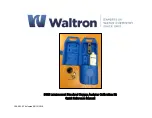
multi N/C 2100S (duo, pharma)
Troubleshooting
99
Error indication
Values of the NDIR detector displayed in yel-
low under Optical bench.
¡
The analog values of the detector are at
the edge of the working range.
¡
Check the halogen trap. Replace the fill-
ing if necessary.
¡
Contact the application team and get
tips on application regulations for diffi-
cult sample matrices.
The analog values of the NDIR detector, the ADU values, can be checked in the software
with the Instrument |Component Test menu option in the Optical bench tab.
You can continue measurement even if the ADU values are displayed in yellow. The dis-
play notifies you that the detector is leaving the optimum working range.
The ADU values slowly shrink due to aging. If the values drop after a few analyses, the
analysis gas is probably causing damage to analyzer components.
7.3
Device errors
This section describes a number of device errors and analytic problems, some of which
the user can rectify himself. Most of the device errors described are easy to identify.
Most of the analytic problems lead to implausible measurement results. If the suggested
solutions do not eliminate the errors/problems, and if such problems occur frequently,
contact the customer service department of Analytik Jena GmbH.
Error
Water traps clogged
Cause
Remedy
¡
The service life of the water traps has
elapsed.
¡
Measuring of samples with strong
aerosol generation.
¡
Replace the water trap.
Error
Scattering measurements
Cause
Remedy
¡
The combustion tube filling is used up.
¡
Replace the catalyst.
¡
The dosing is faulty.
¡
Check the dosing.
¡
Check the set syringe volume in the Op-
tions window in the Analyzer compo-
nents tab.
¡
The canula is damaged.
¡
Replace the canula.
¡
Use a canula suitable for particles if the
substance contains particles.
¡
Inhomogeneous samples.
¡
Warm up cold samples before analysis.
¡
Filter samples prior to analysis.
¡
Stirring insufficient.
¡
Stir particulate samples. When measur-
ing with an autosampler, adjust the stir-
ring speed in the method.
¡
Sensitive samples can be affected by
ambient air.
¡
Prevent the addition of CO
2
or organic
vapors from the ambient air.
¡
Check the ambient conditions and rem-
edy the source of the fault.
¡
Cover the sample vessels on the au-
tosampler with aluminum foil.
¡
Treat the headspace of the sample with
gas.















































